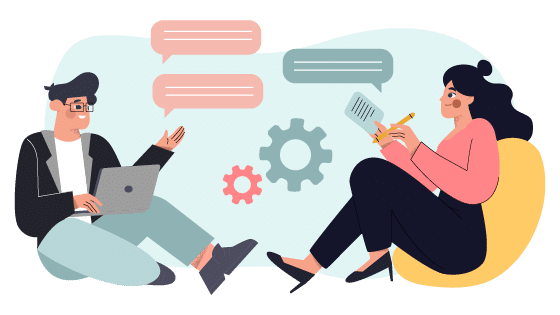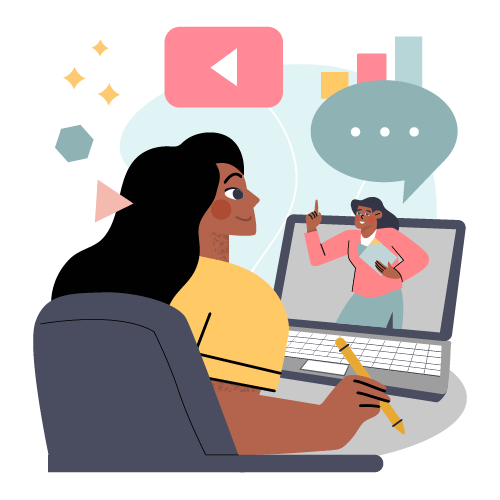Do you think that microlearning is one of those come-and-go trends you’re used to seeing in fashion? That’s not actually the case. While microlearning might sound like an odd way of training employees, it’s both effective and convenient.
In 2020, a typical employee spent around 35 hours on learning and development. That’s fewer than 45 minutes a week dedicated to training activities in the workplace and much less than the duration of traditional learning solutions.
But fitting training into busy agendas doesn’t make the case for microlearning in and of itself. Microlearning is a learning method backed up by psychological and neurological studies. It relies on understanding how the mind reacts to snippets of information. And that’s what we’ll explore in this article, starting with a quick definition of microlearning.
What is microlearning?
Microlearning delivers training in bite-sized portions. Rather than long, in-depth courses that cover multiple concepts, microlearning consists of concise lessons and learning activities that learners take at their convenience in a short amount of time—typically using a smartphone or other mobile device.
When employees first start in a role, they may need macrolearning, such as instructor-led training, during their onboarding process. Those are usually extended programs to learn in detail what their job entails and build the required skills to succeed. But after that—unless the topic is new and complex—your staff will likely only need to refresh their memories. Or they might need to complement the early lessons with extra ones they can rapidly take in.
Microlearning also comes in handy when learners need help with executing a task on the spot.
Microlearning content takes many shapes and forms, such as:
- Short paragraphs or even sentences
- Photos, illustrations, or infographics
- Short videos
- Brief audio clips
- Simple games and challenges
- Quick quizzes
As for microlearning platforms, they often resemble social media networks. But microlearning exists on other types of platforms, such as email or Slack channels.
Microlearning is most appropriate for teaching high-level overviews of a single topic or for breaking down complex topics into multiple microlearnings.
The psychology of microlearning
Why is microlearning so effective? The modern person spends a lot of time absorbing small chunks of information from videos and social media. Our attention spans are shorter than ever before. In a way, we’ve trained our brains to most easily digest small pieces of information quickly. But the science of microlearning is a little more complex.
Repetition
Microlearning isn’t only an effective way of adjusting learning to modern attention spans. It uses repetition to increase long-term memory and avoid the forgetting curve.
In 1885, German psychologist Hermann Ebbinghaus reached some interesting conclusions about memory and learning:
- When we don’t review or apply something we learn, it only takes 24 hours to forget 50 to 80 percent of it.
- It only takes about a month to forget almost all the new knowledge we acquire.
Why? Because our brain records information temporarily unless we use that information often. And the more we use a piece of information, the less effort it takes for the brain to retrieve it.
This brings us to microlearning. While microlearning is effective in and of itself, it also supports employees in keeping the knowledge they acquired through macrolearning in memory and ready to use.
Imagine your staff took an extensive online new hire training course when they joined your company. For each hour of that (macrolearning) course, you can rely on a microlearning solution to encourage them to:
- Review the acquired knowledge for 10 minutes 24 hours after completing the new hire course
- Do the same for five minutes one week after they complete that course
- Quickly repeat the review for less than five minutes one month after finishing the new hire training
This tactic of reviewing lessons at increasingly longer intervals is called “spaced repetition.” And its primary goal is to help your workforce retain that knowledge in their long-term memory. The trick is training the brain to access information in its short-term memory so frequently that it ends up storing it in the long-term memory.
There’s no point of employee training if lessons vanish from the staff’s minds shortly after completing them. Remember: If you can’t retain, you can’t apply.
Retrieval
Reviewing a lesson isn’t re-reading its main takeaways only. It includes retrieving that knowledge from memory and somehow applying it. It’s through repeated practice that you promote long-term knowledge retention. Practice is more effective than study. Combining repeated reviews with repeated retrievals increases the likelihood of long-term knowledge retention.
Testing your employees’ memory makes that memory more potent and the information easy to remember. That’s what “active recall” of knowledge is all about. With microlearning, you can keep asking your workers to apply the knowledge you taught them. For instance, you can post weekly quizzes of important information to keep memories fresh.
Assessment
That’s not the only potential use of short quizzes. Quizzes are fantastic to consistently (and unobtrusively) assess your employees on necessary skills and knowledge.
Periodically evaluate the knowledge your staff retained from employee training according to these two criteria:
- Correctness—whether that knowledge is as accurate as when they acquired it
- Confidence—the degree to which they’re confident in what they know about the topic
Besides measuring the effectiveness of your training programs, you’re also enhancing the memory of your staff. You’re making them retain what they learned longer by reviving the memory of those lessons over time.
Interleaving
There’s one last thing you can do with microlearning to prolong knowledge in your employees’ memory. That’s interleaving training topics.
This means teaching your staff two or more related topics over the same period of time. And it translates to simultaneously taking two training courses—on two different, yet related, topics.
By learning multiple topics at a time, your workers will learn something new every day. And that’s a training delivery pace for which microlearning is very effective.
Plus, alternating between topics on the same day (or every few days) simulates the real world. Because let’s face it, most of us multitask daily. And that’s one of the reasons why we maintain the concepts, ideas, or skills we learn in our memory for a long time.
How to benefit from the psychology of microlearning
Now that you understand the psychology and neuroscience behind microlearning, you’re ready to explore what microlearning brings to corporate training programs.
Learner motivation
What do you prefer for learning a high-level overview of a topic: a long lecture or a five-minute interactive video? Most people would prefer the shorter video.
Delivering corporate education with microlearning—such as a quick interactive video—motivates your employees. It enables them to take training swiftly, which is much more engaging and less daunting than digesting a long lecture or a whole textbook.
Sense of accomplishment
With traditional training, you might only experience a sense of accomplishment after completing an entire course or program. On the other hand, microlearning allows your staff to experience that feeling much more often.
And the sense of accomplishment is as strong as the connection between learning resources and learners is positive. That’s why microlearning relies on varied and engaging materials, from quick videos and flashcards to quizzes and games.
Sensory retention
The information you obtain through your senses will only live in your memory for a limited time—at least, with the original level of detail. For instance, unless you see someone frequently, you’ll forget most of their facial details. The brain stores sensory information sparingly and in its short-term memory. And that’s because our senses are constantly capturing information. But when we manage to move that information into our long-term memory, we become able to store more information longer.
Now, how do you help your employees do this? By activating as many senses as possible during the learning process. That’ll increase knowledge retention in your staff’s minds. All you have to do is provide your learners with multimedia resources about each training topic—text, images, audio, recorded videos, and animations.
How ELM uses the psychology of microlearning
The most effective training feels natural and unobtrusive to its employees. But it also helps them to remember what they learned over a long time. And microlearning is highly effective in that sense because it uses scientifically proven strategies.
Just like we do at ELM! We rely on the psychology of microlearning to make our client’s training programs stay fresh in their staff’s memory for years. Check out our microlearning solutions!






